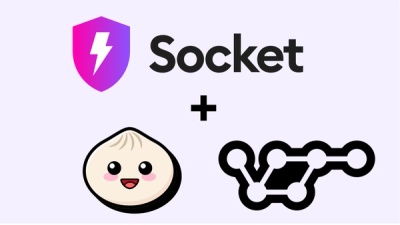
Product
Introducing Webhook Events for Alert Changes
Add real-time Socket webhook events to your workflows to automatically receive software supply chain alert changes in real time.
canopy-webpack-config
Advanced tools
Some defaults for webpack configs at Canopy.
First, install the library as a devDependency.
yarn add --dev canopy-webpack-config @babel/runtime @babel/plugin-transform-runtime
Now create a webpack.config.js file. This file will use canopy-webpack-config and allow you to override anything you want to about the defaults. Inside of the
file, call the canopyWebpackConfig() function to get some defaults and add/override to your webpack config. See example below:
// webpack.config.js
const canopyWebpackConfig = require('canopy-webpack-config');
module.exports = canopyWebpackConfig('login-ui', {
// Override or add anything you want to your webpack config
module: {
rules: [
// e.g. apply a css loader if using css-modules
{ loader: 'css-loader' },
],
},
})
Finally, create the following scripts in your package.json:
{
"scripts": {
"build": "webpack --config webpack.config.js --env.analyze=static",
"analyze": "webpack --config webpack.config.js --env.analyze=server",
"start": "webpack-dev-server --port"
}
}
You'll need to add SSL certificates to ~/.canopy-ssl/, or define your own by changing the start script above to webpack-dev-server --cert {location} --key {location} --port
Now add yarn build to your .gitlab-ci.yml file for the build step. You can run yarn analyze at any time to see your bundle size and breakdown. And yarn start
will start up a web server that is ready to go as a sofe override.
canopyWebpackConfig(name, config): The default export of the canopy-webpack-config npm library. This function requires both of its arguments.
The first argument is a string name for the library you are exporting. The second is a webpack config that will be merged with the defaults that
canopy-webpack-config provides. The library will put the bundled files into the "build" directory. Note that this project assumes that you use
babel-loader, but it does not install babel-loader. So you'll have to install it yourself, at whatever version you prefer.--env.analyze=server|static|disabled: An option you can specify when invoking the webpack cli. For example: webpack --config webpack.config.js --env.analyze. This will open
a bundle analyzer that lets you see the byte size of all your code splits and bundles. And the breakdown of what libraries and files are big and causing the
byte size to be large. See webpack-bundle-analyzer for more details.--env.dev: An option you can specify when invoking the webpack cli. For example: webpack --config webpack.config.js --env.dev. This will force the webpack
build to be done in development mode. Note that this is unnecessary for webpack-dev-server, which already forces the config to be in development mode without you
needing to do anything.To see your full webpack config, simply add a --env.debug to your webpack cli command.
canopy-webpack-config assumes a few things about your project and provides defaults for those things:
build directory relative to where you started the webpack process.the webpack config for canopy-webpack-config will always create the output bundle in the directory that the webpack process was started in. This is different than how webpack configs normally work -- they usually create the output bundle in relation to the directory in which the webpack config file is placed.
We support a few config options for builds, including typescript and an externals submodule.
module.exports = canopyWebpackConfig('login-ui', {}, {
typescript: true,
externals: true
})
<bool>Pass an options object with {typescript: true} when your service uss typescript.
<bool>Pass an options object with {externals: true} when you are looking to export a submodule from /src/externals.{js|ts}. This should be for exports that must be imported synchronously such as hooks or queries that do not have other internal dependencies (to avoid circular dependencies).
FAQs
Some defaults for webpack configs at canopy
The npm package canopy-webpack-config receives a total of 258 weekly downloads. As such, canopy-webpack-config popularity was classified as not popular.
We found that canopy-webpack-config demonstrated a healthy version release cadence and project activity because the last version was released less than a year ago. It has 10 open source maintainers collaborating on the project.
Did you know?

Socket for GitHub automatically highlights issues in each pull request and monitors the health of all your open source dependencies. Discover the contents of your packages and block harmful activity before you install or update your dependencies.

Product
Add real-time Socket webhook events to your workflows to automatically receive software supply chain alert changes in real time.

Product
Socket now scans OpenVSX extensions, giving teams early detection of risky behaviors, hidden capabilities, and supply chain threats in developer tools.

Product
Bringing supply chain security to the next generation of JavaScript package managers